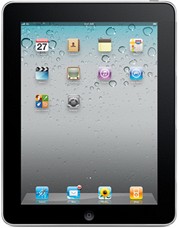Back in 2010, there was just the Apple iPad and the Samsung Galaxy Tab in the shops, tablet-wise. We’d seen the BlackBerry Playbook and were patiently waiting for a UK release date.
Now there’s the Motorola Xoom and the Dell Streak 7, both confirmed for the UK, and both of which run on Android. Toshiba and Panasonic are working on some yet-to-be named Android tabs as well.
We’ve said it once and we’ll say it again; if 2010 was the Year of Android Phones, then 2011 is going to be the Year of Android Tablets.
Though absent from CES, the follow up to the iPad made its presence felt. Given the prevalence of tablets that are coming with a dual-camera set up, we’re going out on a limb here and guessing that the iPad 2 will feature this too. We think given the competition its up against, the iPad 2 is going to have to be something special. So, without further ado, here's how we reckon the first round of the 2011 Tablet Wars is going to go down.
iPad 2

With Facetime on the iPhone 4 , Apple managed to convince everyone that video calling was cool and useful. For this reason we’d be very surprised if the iPad 2 didn’t roll with a couple of cameras to facilitate this. We imagine that the main camera will at least match that of the iPhone; i.e. 5-megapixels, HDR mode, records HD video etc. We think that the secondary camera would be at least 2-megapixels, a la the competition. Or, they might go one better and a have a front-facing camera that’s of equal power to the main one.
Motorola Xoom

Having seen the Motorola Xoom in action we can safely say that the iPad 2 is going to have to be something special to beat this. The Motorola Xoom looks fantastic, both outside and in. It's got a beautiful reflective finish, and no physical or exterior keys, as everything is done on the 10.1-inch touchscreen. Android 3.0, as we all know, is the first OS from Google to be tailored specifically for tabs. It is hands down the nicest we’ve seen Android looking on
any device so far. The Xoom plays 1080p HD video effortlessly, features two cameras (5-megapixels w/ flash on the back, 2-megapixels on the front) and has a whopping 32GB of internal memory. Scared, iPad 2? You should be.
BlackBerry Playbook

Like the Motorola Xoom, the BlackBerry Playbook features a 1Ghz dual-core processor, and is a capable multitasker. We’ve seen it
running games while keeping the browser open while powering through high definition videos. We particularly like the look of the browser and
how Facebook is integrated. The Playbook’s got a 7-inch screen as opposed to those of the Xoom and (we guess) the iPad 2. We have to disagree with Steve Job's comment about 7-inches not being enough. In our review of the Galaxy Tab (which also has a 7-inch screen) we found this to be just about fine, size-wise. Having not had much real hands-on time with the Playbook or RIM’s Tablet OS, it’s hard to say how it’ll compare against iOS 4, Android 3.0 or even Android 2.2. Our money’s on it being a bit more suited to tablets than Froyo though.
Dell Streak 7

The Dell Streak 7 might not boast the visual loveliness or the tablet optimisation of Android 3.0 as runs on 2.2/Froyo (with a 2.3 Gingerbread upgrade to follow). And, it doesn’t boast the same screen size of the Motorola Xoom (7-inches opposed to 10). But it’s
packing a Tegra 2 processor, meaning it’ll be able to handle high-end titles like Dungeon Defender: First Wave no problem. The smaller size might make it more of a hit with gamers, as it's going to be more portable than a 10-inch tab. The Dell Streak 7 is set to come in 16GB and 32GB flavours. Presumably the 16GB edition will be a bit easier on the wallet, compared to something that’s got a bigger screen and only available in a 32GB size.





































